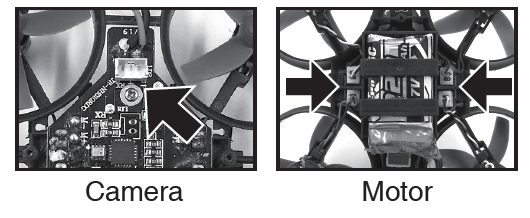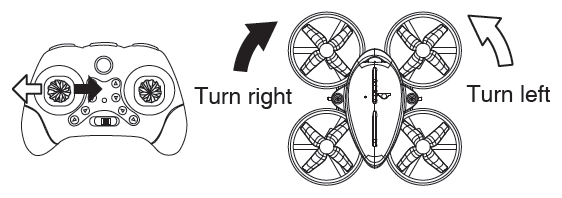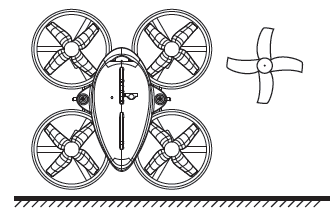FPV six-axis AircraftUser Guide

1.0 Know your aircraft
The main structure of the ABS material, the new industrial and modular design, improve product development, easy installation and maintenance, replacement upgrades.
Equipped with FPV 5.8G map transmission real-time transmission system, bring you not the same visual effects.

1. Aircraft shell2. Cover the screw hole3. FPV system4. EVA pad (fixed camera)5. Rack6. Rack cap screw hole7. Forward rotation propeller8. Reversing the propeller9. Propeller guardrail10. Body battery compartment11. Battery
1.1 The architecture of the aircraft

2.0 Parameters
Craft parameter
- Wheelbase: 66mm
- Size: 83.5×83.5×45.6mm
- Weight: 20g(without battery)
- Motor: 6015 1S brush motor
- Lipo battery: 3.7V 220mAh 35C
- Flight time: 5 mins
- Omnidirectional reception antenna
- Working temperature:-10℃ to +40℃

Frequency Table

3.0 Frequency method
FPV system :5.8G 40CHSee Table 3 on the frequency table

Key functions:
- Short press the button to adjust the frequency function, and at the frequency FR1-FR8 cycle between the switch.
- Long press the button for 2 seconds (LD1 flashing when the release button) for the adjustment frequency group function, and in the frequency group CH1-CH5 cycle between the switch.
- Long press the button for 5 seconds (LD1 from flashing to off when the release press key) to adjust the standard function, P system LD2 flashing, N system when LD2 long bright.

4.0. remote control
4.1 Remote control function introduction

4.2 Remote control battery installed

5.0.Aircraft Lipo battery charging
Plug the USB plug into the USB port of the computer (or the charger of the USB port with the DC5V output). At this time, the USB charging port has a red indicator light and the battery is connected to the USB charging cable. When the red light keep on ,it means battery full charged. Charging time need about 50mins.To ensure safety ,Charging must be within sight.

6.0.Operational guidelines
6.1 Boot program

6.1.1. The battery into the fuselage battery compartment, then the battery port access to the fuselage power port, and placed on the level, then the aircraft taillight flashing, open the remote control power switch, remote control issued a “tick” sound, then remote control The remote control gives a “beep” once again, and then the remote control indicator is turned on again. At this time, the remote controller will be issued again. Bright, the aircraft LED light is always bright, said the completion of the code.
6.1.2. After the code is completed, it can take off in the following two ways:
- Short press one key to take off, the aircraft will automatically climb to a certain height.
- After the code is completed, do unlock operation at first, Then slowly push the joystick after unlocking after the aircraft climbs up to a certain height, release the rocker to stop the climb.

6.2 Gyroscope proofreading Calibration method:
After the code is completed, the outer “ ”figure is calibrated, the left joystick points to the left corner at 45°, and the right joystick points to the left corner at 45°
Unlock method:Unlocked with figure eight“ ”, left joystick points to left corner, right joystick points to right corner.Locking method: Repeated unlocking operation.

Note: with altitude hold function
6.3 Motor And Camera All Upgrated To Interface Mode
Motor and camera are plug design, more convenient to replace parts.

6.4 Taillight of aircraft
When the aircraft is low voltage, the taillight will flash.

Tips: Before the aircraft take off, be sure to place the aircraft in the horizontal position for proofreading, to ensure the aircraft can fly smoothly . When the aircraft suffer the impact or collision after the deviation, you can also use this method to calibrate the gyroscope.
Tips: low alarmWhen the aircraft appears tapping flashing, indicating that the aircraft is about to run out of power, then the aircraft Will automatically turn off the trick, the aircraft in the conventional control state, the maintenance time of 30 seconds.
7.0. Operation and control
7.1 Mode of operation
As sensitive, for beginners, it is recommended to slow operation of the rocker. Such as the operation of the aircraft during the process of a slight decline, but also slowly push the left rocker to climb to a certain height. Operation to avoid a significant push of the throttle.

When the left joystick (throttle) is pushed up or down, the aircraft rises or falls accordingly.

When the right operating lever (direction) is pushed up or down, the aircraft forwards or retracts accordingly.

When the left joystick (throttle) is pushed left or right, the aircraft turns left or right accordingly.

When the right-hand lever (direction) is pushed to the left or to the right, the corresponding side fly or fly on the right side of the aircraft.
7.2 Operation mode
(with altitude hold function)
Aircraft movements fine-tuning Slowly raise the throttle stick, when the aircraft to leave the ground, if the aircraft tend to different.
- Adjust the front and rear fine adjustment When the aircraft leaves the ground, the aircraft is moved forward / backward, forward, and the fine
- Adjust the aircraft side fly fine tuning When the aircraft leaves the ground, flying to the left / right side of the side fly.Fly to the right, fine-tune the left to adjust.Fly to the left, fine-tune the right to adjust.

8.0. 360 ° Rollover
(Reminder: When the battery capacity is power off, it will automatically turn off the function.)
The aircraft can do 360 ° rollover by the following joystick operation.

Note: Keep the aircraft at a height of 2-3 meters when rolling, so that the aircraft is easier to maintain the height after rolling.
9.0. Headless mode
9.1 Headless mode switching
Start and set: After the completion of the aircraft frequency, the aircraft placed in the flat level, or hover in the air to ensure that the head of the aircraft and the remote control in front of the same direction, press the headless mode button (aircraft LED lights flash) Start headless mode.Exit the headless mode: Press the headless mode button again (the aircraft LED is lit), then exit the headless mode.

As shown in the figure above, in the headless mode (the aircraft LED is in a flashing state), regardless of where the aircraft is located in front of the location, now the remote control is located in the rear of the aircraft, then pull down the direction of the operating lever You can recall the aircraft, push up the direction of the rod so the aircraft will fly farther away.
9.2 One key return
Press the button to return to the channel, you can correct the way through the right joystick to correct the channel (to the front of the frequency before the start in order to return to normal), the aircraft will automatically return.During the return process, press the function key combination on the remote control or push the right joystick “forward” to return the aircraft.

10.0. Flying environment

Do not use this product in the following environments to avoid accidental injury or damage to the aircraft.
- high-voltage line lots, park lots, railway lots, highway lots and so on
- thunderstorms weather, windy weather, rain and snow weather.
11.0. End flight
- Manual landing.
- First turn off the power of the aircraft, and then turn off the remote control power.
- Remove the aircraft from the aircraft.
Do not use this product in the following environments to avoid accidental injury or damage to the aircraft.
- high-voltage line lots, park lots, railway lots, highway lots and so on
- thunderstorms weather, windy weather, rain and snow weather.
12.0. Propeller installation method
The propeller of the aircraft is installed with the location requirements, please press the corresponding code to install, coded as shown below.
Install the propeller: Hold the small hat of the propeller, press the motor shaft to press it, be careful not to deform the propeller.

13.0. Troubleshooting
13.1 remote control and the aircraft did not respond to the solution:
- Make sure the code is successful. See page 4 for the code method.
- whether the battery is low.
- Make sure the remote control is the original match.
13.2 Can not roll the solution:
- Restart the rollover function key.
- Check whether the lithium battery is too low, re-charge.
13.3 aircraft fuselage solution:
- Check if the propeller is deformed and replace the new propeller.
- turn off the aircraft power to restart.
- Place the aircraft in the horizontal plane to recalibrate the gyroscope.
13.4 Aircraft can not take off the solution:
- Check that the screw is installed correctly.
- whether the aircraft crash cover is loose, hinder the propeller rotation.
- whether the aircraft has electricity, low power, the lights flashing.
14.0. FPV Troubleshooting
14.1 Goggle display screen No image:
- Check to see if the power supply of the goggle and the power supply of the aircraft is normal, battery power is sufficient.
- Check whether the goggle receive channel and transmitter channel is consistent.
- Check the transmitter and the end of the goggle N / P standard is consistent.
14.2 Goggle received the image signal quality is poor or wireless transmission distance near:
- whether the same frequency of radio transmission equipment interference, FPV system should choose other frequencies, to avoid the interference frequency or to avoid the use of the same site.
- Whether the goggle antenna is installed.
- whether the goggle and the aircraft between the mountains, houses, trees and other obstacles, please use the FPV system in the open space.
15.0. Accessories list

[xyz-ips snippet=”download-snippet”]

